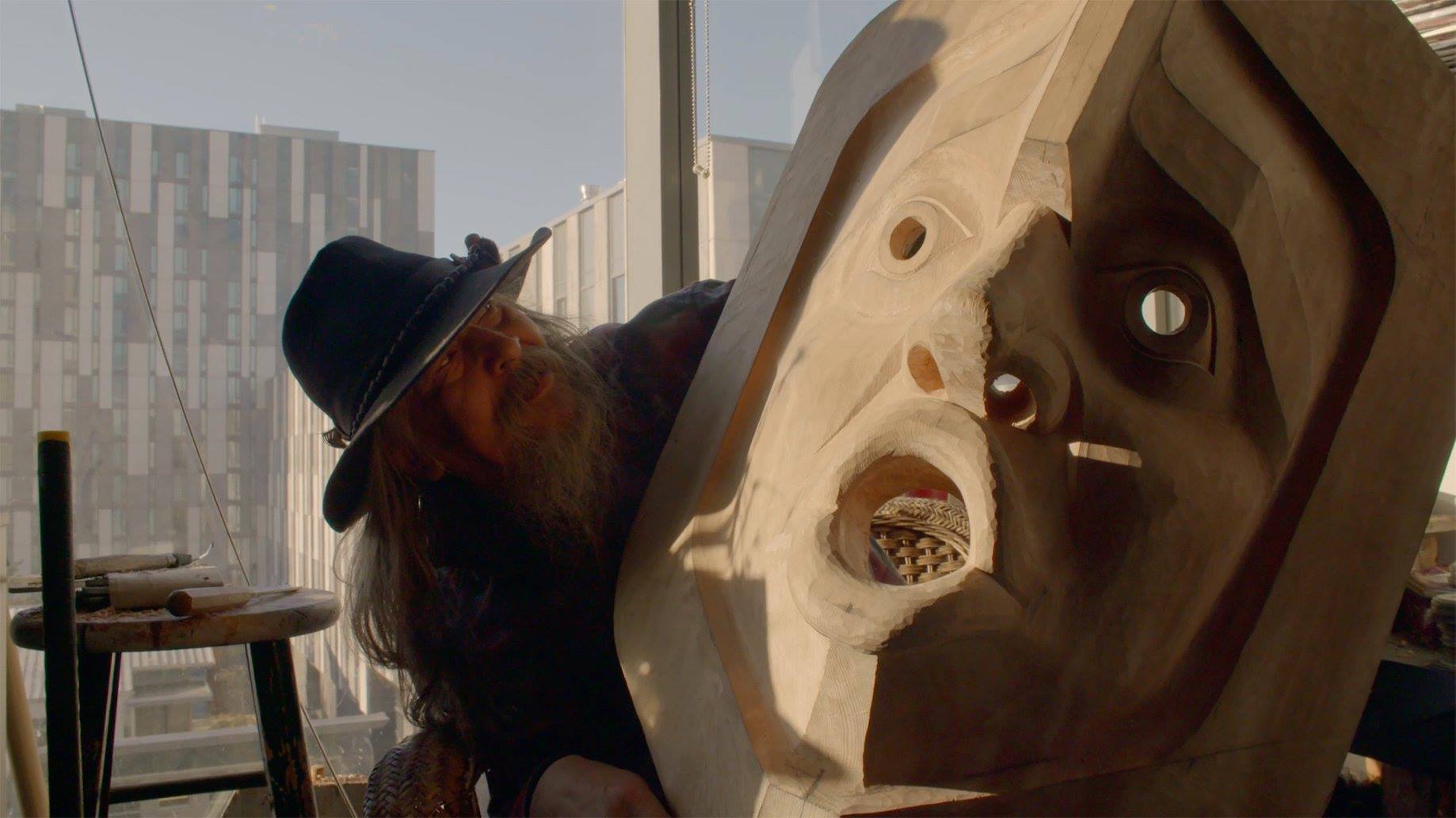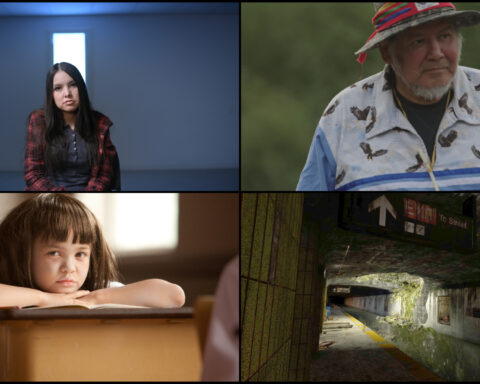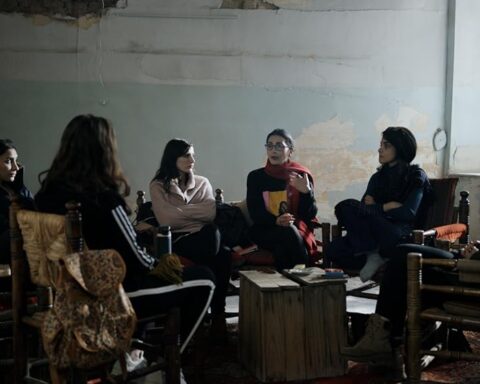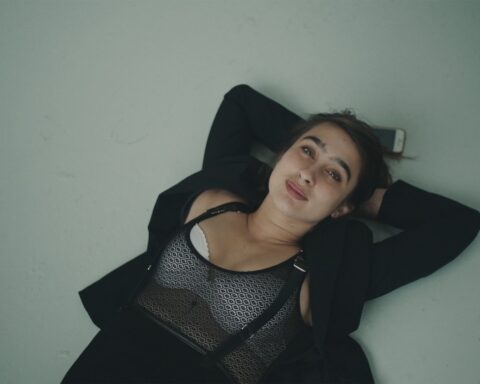This year’s Canadian documentary selection at the Vancouver International Film Festival is highlighted by a pair of portraits of gifted British Columbia-based artists: Natalie Boll and LaTiesha Fazakas’s Meet Beau Dick: Maker of Monsters, about the eponymous Kwakwaka’wakw master carver and mask maker, and Melanie Wood’s Shut Up and Say Something, which follows the explosive spoken-word performer Shane Koyczan and also screens at the Calgary International Film Festival
Viewed side by side, the two films have a surprising amount in common, both on the surface and underneath it. Both films were produced in collaboration with their subjects and feature David Suzuki in talking-head-testimonial mode to explain the cultural importance of their respective narratives. In addition, animation techniques are employed in each film to bring aspects of the art under discussion to cinematic life.
A political dimension also unites Maker of Monsters and Shut Up and Say Something. Dick, who died earlier this year at the age of 61, was a life-long activist for First Nations issues, leading a “coppercutting” ceremony on the steps of the B.C. Legislature in 2013 as part of Idle No More and rallying other members of his community to the cause. Koyczan’s poems, which were memorably featured during the opening ceremonies of the 2010 Vancouver Olympics, are typically seen in terms of individual expression rather than ideology, but the harsh legacy of Canada’s residential schools is evoked through the presence and memories of his estranged father, Len.
Len and Shane’s on-camera reunion transforms Shut Up and Say Something from an affectionate profile of an unconventional but phenomenally successful Canadian poet into a family affair. “I was insistent on that narrative spine from the beginning,” says Wood, who made the film in collaboration with Stuart Gilles, a close friend of Koyczan’s. “[Stuart] had the idea of including the personal bits… That’s what made me want to produce the film. If it was just a performance film or a tour film, that’s not as interesting for me. I wanted to do Shane the courtesy of making the film about him as meaningful and transcendent as his poetry is. Otherwise, it’d just have been another art piece that only speaks to people who are already fans.”
Koyczan has a lot of fans. The clip for “To This Day” has over 21 million views on YouTube. Shut Up and Say Something features plenty of footage of Koyczan onstage, where he cuts an unusual but compelling figure: short and rotund behind thick glasses and scraggly beard (“I look like the love child of Hagrid and Harry Potter,” he laughs), he holds audiences spellbound through a combination of slam poet-style showmanship and sheer linguistic mastery. His poems address everything from loneliness and isolation to drug addiction to Canadian identity; in each case, he eschews cliché for pointed and potent specificity.
Shut Up and Say Something features several striking animated interludes that visualize the ideas of Koyczan’s poems, but there are also moments when Wood simply keeps the camera trained on the stage and the audience (or both, in split-screen) to show the overwhelming effect of his oratory. “When he performs,” she says, “he is so in the moment, so raw, so willing to rip himself open and share old scars and old emotions that an audience can’t help but be drawn in.”
“We are graduating members from the class of Fuck Off We Made It,” thunders Koyczan near the end of “To This Day,” a powerful memory piece that folds the author’s experiences of being bullied as a child into a collective narrative about the possibilities of perseverance. “I love ‘Move Pen Move,’” says Wood when asked to name her favorite title in Koyczan’s repertoire. “It makes me cry every time, and also reminds me of the importance of being present for family when family needs you. His performances transcend live and survive very well on film. That is, I think, part of his success online. He is watchable on the internet with the same full power as live performance.”
Shut Up and Say Something, which was a commission by B.C.’s Knowledge Network, begins with its subject at the peak of his powers and popularity—a human viral video who gets stopped in the street by admirers. It then doubles back, literally and figuratively, to the primal scenes of his pain. The film takes the form of a West Coast travelogue, taking the poet back to his childhood home and then for a meeting with his father—his first in many years. “Every superhero wants to know his origins,” says Koyczan, who was raised in the small town of Penticton by his grandparents after his parents abandoned him: he dotes on his grandmother, Loretta, who smilingly recalls him telling her as a young boy that he wanted to be a “chameleon” when he grew up. Koyczan meant “comedian” but the malapropism is poetic. His skill with language has rendered him a shape-shifter of sorts, able to shift into different roles in his performances without ever abandoning his central identity.
The goal of Koyczan’s meeting with his father is to ask questions about his childhood that had sat unanswered for decades. But their first extended conversation actually dredges up the older man’s adolescence, when he was taken and sent to a residential school; it’s an event he compares to being “kidnapped.” Without overstating the case, Shut Up and Say Something implies that this was the first step in Len’s troubled path, which left him unprepared for fatherhood at an early age. “I think Shane’s father telling his truth is all we’d ever planned to do,” says Woods. “I wanted to make sure that what Len and Shane found out together about each other was told through their journey of discovery, and not from anything that we, the filmmaking team, imposed. It just is what it is…it unfolded the way it did. We simply allowed it to be told by including it in the film. It does help Len explain his part of the story.”
As the film goes on, Koyczan is forced to process the raw materials of the trauma that he subsequently carved and shaped into art, pushing past the first awkward reconciliation in an attempt to integrate not only his father but his extended family into a life that’s publically celebrated but privately very lonely. The contradiction of a man who has made his mark via an acute emotional intelligence but feels unloved is moving stuff, and Koyczan’s reluctance to reach out—acknowledged by friends as a defense mechanism that’s difficult to disarm—belies a desperate and palpable desire to connect.
In the film’s powerful final sequence, he invites his father to listen to a recording of a new poem addressed directly to him. It’s a soul-baring confession mediated by a laptop computer and a pair of headphones. Here, the filmmaking rises to the level of its subject’s artistry, juxtaposing a stark, long-take aesthetic with super-imposed text, united by the passion in Koyczan’s voice on the soundtrack. It’s difficult to watch but also rapturously emotional: its catharsis feels earned.
Shut Up and Say Something is ultimately a movie about what happens when an impeccable performer drops his suit of professional armor. Maker of Monsters zeroes in on a man who excelled at creating masks. “I was a young UBC art history graduate when I saw a mask of Beau’s in a sea of other masks,” says Fazakas, who had known Dick personally for 20 years and officially began collaborating with Boll on the film in 2012. “At the time I didn’t know much about Northwest Coast culture and art and was having trouble connecting with it until I saw Beau’s work. The mask was delightfully terrifying in a way that wasn’t grotesque but sublime. It was like he reached out to me through his work and piqued my interest in a way that gave me a thirst for more knowledge. I stood there holding his mask and thinking, ‘This is a true artist. Wow. Canada has greatness right here.’”
“LaTiesha asked me to come to her house to see a mask from an artist named Beau Dick,” recalls Boll. “I was not familiar at the time with his work. She thought he would make a great subject for a documentary. I walked into her home to find a large Tsonoqua mask. Immediately I had shivers run down my entire body. It was unlike any mask I had ever seen in my life. It was powerful, it had a spirit, and it was alive.”
The title Maker of Monsters refers to the various spirits and creatures brought to life by Dick’s prodigious craftsmanship, but it’s also suggestive of the difficulty that the art world has had reconciling works by Indigenous artists into the gallery space. Onscreen, Dick comes off as affable and avuncular—a charismatic man beloved in many different circles—and yet as his work began to be featured in an international context, including a prestigious commission by curators Monika Szewczyk and Candice Hopkins in 2016 for documenta 14, he also came to represent a larger force encroaching on the canon.
“I liked the idea of a film that questioned Western art and social constructs and I thought monsters were a provocative way to do so,” says Fazakas. “I worked in a tourist gallery that mostly catered to a conservative audience that favored ‘nice’ works and Beau didn’t always play nice. I liked that Beau’s work was provocative in a market that preferred its Native art and artists to be more subdued. I liked the rebellious nature of his work. I liked that it spoke to a much more real version of native culture on the coast, not the Disney version more easily digestible for tourists.”
“I think art and artists play a significant role historically in activism,” adds Boll. “For some people, political issues seem very daunting. Artists like Beau have a crucial role in opening up an important conversation in a way that intrigues individuals.”
Maker of Monsters makes the links between these two spheres of practices clear, and the footage of Dick at the “copper-cutting” ceremony—smashing a copper shield against the steps of the provincial legislature in a ritual meant to confer shame—is rousing and inspiring. “When things finally got going, the energy was otherworldly,” recalls Fazakas. “The Hamatsa cries that came with each blow brought tears to my eyes and shivers down my spine. You really could feel the power of the ceremony emanating from the participants. The sea of onlookers and fellow activists gave you a sense that we were witnessing something very special.”
“When we started filming, our Canadian Prime Minister was Stephen Harper,” says Boll. “Although he had formerly apologized in 2008 to the survivors of the residential schools, little to nothing was done. His environmental policies were catastrophic. So, when Trudeau became our Prime Minister in 2015, there was a lot of hope that things were going to change. I was filming with Beau the day that Trudeau announced his approval for the Kinder Morgan’s Trans Mountain pipeline. Beau immediately got up and left his studio and went downtown to protest. There was such a feeling of disbelief and disappointment that Trudeau was not standing by his promises.”
Both filmmakers say that the project would not have been possible without Dick’s enthusiastic participation and support—and transparency about a personal life that was sometimes tumultuous. “Up until the last day of filming, Beau was still open about his life,” says Boll. The rough edit was completed in time for Dick to see right before he passed away. “His death made me feel like what we did with the film was just that much more important,” says Fazakas. “It is now part of his legacy.”












